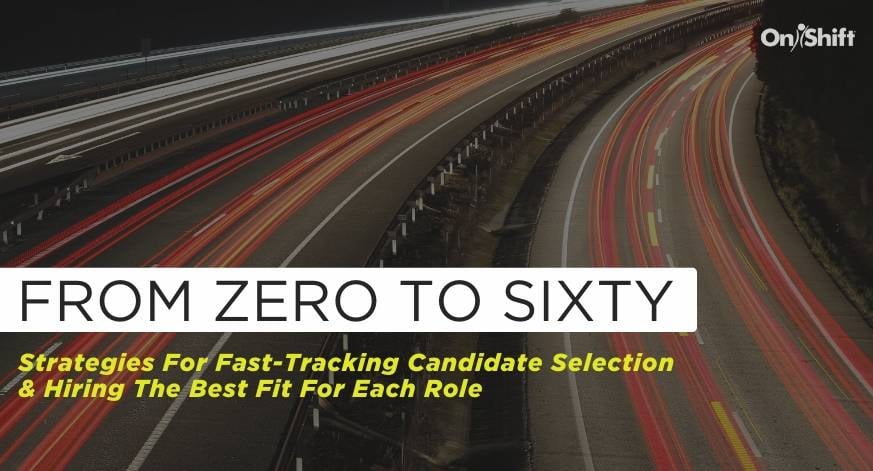
Since time is of the essence when it comes to hiring hourly workers, many of your best applicants could be slipping through the cracks. Here are some tips to help you efficiently narrow down your pool and hire top talent before your competitor does.
- Ask Pre-Qualifying Questions
Asking pre-qualifying questions ensures that neither your hiring manager’s nor applicant’s time is wasted. You can objectively weed out those that do have the right skillset for the job almost immediately, just by including a few basic questions in your application.
Have all candidates start their application by listing their certifications and job credentials. If they don’t have the required training and experience, you can quickly disqualify them from this particular position.
Other common qualifying questions include asking applicants when they can start, their career goals and why they are interested in working for your company. Keep in mind that many candidates are applying from their phones -- and may even be doing so during a quick break at their current job. Therefore, you want to be mindful of how many pre-qualifying questions you ask. The more lengthy and complex an application is, the more likely an applicant is to abandon it.
- Use Behavioral Assessments
You can begin to narrow down your pool even more by conducting behavioral assessments. These questions measure a candidate’s values, personality and motivational characteristics to determine if they are the right fit for the role.
When hiring for positions in senior care, providers should look for those that demonstrate patience, the ability to work well with others and, of course, that caregiver spirit. Some common behavioral assessments include the Predictive Index, the EQ-i 2.0 and the DiSC profile.
- Conduct Virtual Interviews
In light of new social distancing guidance, virtual interviews are more popular than ever and will be a part of the “new normal” for the foreseeable future. Not only do virtual interviews keep participants safe, but they are generally more convenient for applicants who would normally have to commute to your community.
Another bonus, they can be more helpful in assessing candidates as they can be recorded, scored and compared. They also ensure another level of compliance, while still maintaining that face-to-face connection, so you can be confident that you’re hiring the right person.
Some popular video chat services that can be used for virtual interviews include Skype, Zoom and GoToMeeting. You can get four quick tips for conducting virtual interviews in our Recruitment Toolkit.
- Implement A Structured Interview Process
To really get the most out of your interviews, you need to be very thoughtful and strategic in the questions you ask. Structured interviews ask each candidate the exact same set of questions in the exact same order. The answers are then scored and can be easily compared to other candidates’ responses.
Not only do structured interviews help you further narrow down your pool, but they allow you to collect the information you need to fairly assess each candidate and keep the interview on track.
Respecting the interviewee’s time is one of the most important parts of providing a positive candidate experience. They may be meeting with you on their lunch break or have other commitments that day.
- Build A Database
Oftentimes, you will have candidates who may have been an excellent fit, but for one reason or another decide to drop out of the hiring process. Perhaps they found another job or may have been passively looking for a new job. Or maybe you have filled all of your roles at this time but know they would be an excellent fit for an opening in the future.
Instead of deleting their application from your system, hold onto it. Then you can share openings as they become available. By building up an internal database, you will always have a place to go when you’re searching for your next best-fit candidate. This can save you a lot of time and money in the long run. Additionally, if you are collecting the data in a talent acquisition system, you own it, instead of a job board, which may use it to retarget candidates for competitive jobs.
- Let Your Workflows Do The Work
Your hiring workflows may be the most powerful tool you have when you have a mass influx of candidates. Your workflow should be customized to your hiring needs, while also incorporating automation to help you stay on track. For example, small nudges can help move your candidates to next steps, such as completing a digital offer letter or sending back a key piece of hiring paperwork needed to remain compliant.
- Dig Into The Data
When it comes to recruiting, there is no end to the amount of data you can collect, measure and use to improve your process. Make sure you’re collecting key hiring data, such as time to hire, referral reports and application stage reports to help you optimize your hiring process in the future.
A talent acquisition platform gives you the ability to do all of the above, putting hours back in the day for your hiring managers, and of course, putting the candidate experience at the center of your efforts. If you’d like to learn more, request a demo of OnShift Employ today.